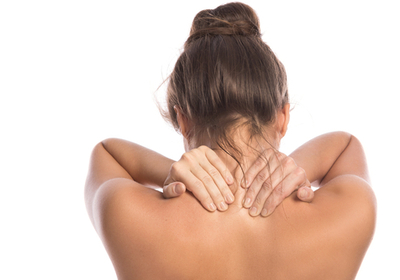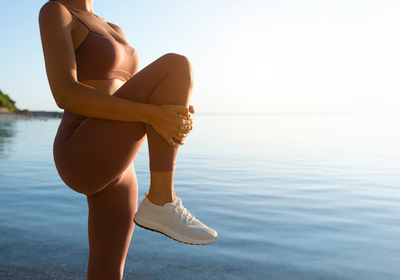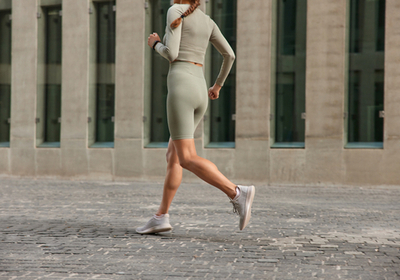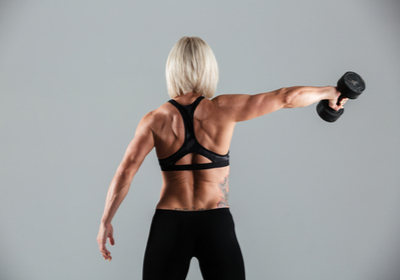VIDEO
Plank Jacks
- Back
- Abs
- Gluteus
- Quads
- Hamstrings
- Calves
- Inner Thighs
Level:Intermediate
Trainer:Amy Young
Equipment:Fitness Mat
Plank Jacks
- Back
- Abs
- Gluteus
- Quads
- Hamstrings
- Calves
- Inner Thighs
Level:Intermediate
Trainer:Amy Young
Equipment:Fitness Mat
Start with the plank position with your arms extended, hands under the shoulders, and your feet together. Your body should be in a straight line from your head to your heels. Engage your abs to protect your lower backfrom injury. Jump off feet wide to each side as you are doing a horizontal jumping jacks.
save to ...
RECOMMENDED FOR YOU
- Core
- Arms
- Legs
Duaration: 00:15
save to playlist
- Core
- Legs
- Abs
Duaration: 00:14
save to playlist
- Biceps
- Trapezius
- Upper Back
Duaration: 00:15
save to playlist
- Core
- Arms
- Legs
Duaration: 00:15
save to playlist
- Core
- Legs
- Abs
Duaration: 00:14
save to playlist
- Abs
- Gluteus
- Hamstrings
Duaration: 00:15
save to playlist
- Core
- Arms
- Legs
Duaration: 00:15
save to playlist
- Core
- Back
- Legs
Duaration: 00:15
save to playlist
- Core
- Legs
- Abs
Duaration: 00:15
save to playlist
- Biceps
- Trapezius
- Shoulders
Duaration: 00:15
save to playlist
- Arms
- Back
- Abs
Duaration: 00:15
save to playlist
- Abs
- Triceps
- Upper Back
Duaration: 00:15
save to playlist
- Core
- Arms
- Legs
Duaration: 00:12
save to playlist
- Legs
- Gluteus
- Hips
Duaration: 00:15
save to playlist
- Core
- Legs
- Abs
Duaration: 00:15
save to playlist
- Core
- Legs
- Abs
Duaration: 00:15
save to playlist
- Core
- Arms
- Legs
Duaration: 00:15
save to playlist
- Core
- Legs
- Biceps
Duaration: 00:15
save to playlist
Blog
Trapezius muscles are often underestimated, and many people don’t pay much attention to them while working out. However, it is a huge mistake because these muscles are extremely important for the right posture as well as back health. So in this article, we’ll talk about trapezius muscles and how to develop them.
Why Do I Need to Work on Trapezius Muscles?
The trapezius is a part of the upper back which helps us to maintain the right posture. The muscle group consists of three different parts, which are top, medium, and bottom. Together with the muscles of the neck, the trapezius is responsible for the right posture. The upper part of this muscle is responsible for the rise of the shoulder as well as the ability to lift arms. The lower one - is for lowering shoulders and arms. At the same time, the middle one is needed for blade movement. As you can see, this muscle group is responsible for many basic functions, which is why developing the trapezius muscles is extremely important for everyone, especially for those people who have some problems with their posture.
How Often Should I Do Trapezius Workouts?
Ideally, you have to include at least 2-3 trapezius exercises in each workout session. At the same time, you have to work out 3 times a week. In some cases, it’s better to have 4 training sessions per week. In case you have some issues with your posture and you cannot keep your back straight because your spine muscles (especially trapezius) are weak, we recommend doing at least a few exercises for trapezius muscles every day.
Who Needs Trapezius Exercises the Most?
Of course, everybody needs to straighten their trapezius muscles, but, obviously, some people need it more than others. So who are those people? Well, here is a short list of those you must pay more attention to their trapezius muscles:
Office workers who work long hours at the desk
People who have posture problems and struggle to keep their back straight
Athletes and fitness enthusiasts who lift heavy weights
Boxers, volleyballers, basketballers, and other sportsmen who actively involve their arms in their sports activity
Dancers and gymnasts who need strong and developed back muscles
Do you belong to any of these groups? Then you better start working on your trapezius muscles now.
Best Workouts for Trapezius
Last but not least, we would like to recommend you some trapezius workouts, so here they come:
Shrug
Deadlift
Shoulder blade squeeze
Barbell row
Upright row
Reverse dumbbell flyes
Chin-up
Pull-up
Push-up
Lat-pulldown
Rear delt cable raise
High pulley cable row
Overhead farmer's walk
Y raise
Rope rear delt pull
Wrapping Up
Trapezius muscles are super important for your back health, so no matter what your occupation is or how often you work out, you still need to find at least a few minutes for some exercises for the trapezius.
Read more
The Kardashians have created many beauty trends, one of which is having beautiful buttocks. So, in this article, we'll talk about building great gluteus muscles so you can look as attractive as Kim, Kourtney, and Khloe. Let's begin by looking at the anatomy. The glutes are made up of three main parts.
The gluteal maximum muscles, which are the largest muscles in the body, help to maintain balance when walking and running. They allow your legs to move sideways and are also responsible for contouring the shape of the buttocks.
The gluteus medius is overlaid in part by the gluteus maximus and is located at the top of the pelvis. It is involved in leg extension, lateral flexion, and body stabilization during the movement.
Finally, below is the gluteus minimus. Both are in charge of leg induction and body stabilization, as well as shaping the thigh line.
Training for the glutes
Building your glute muscles isn't easy, particularly when you're on a tight schedule. However, by working out at least three times a week and never giving up, you will quickly reach your goal. To help you achieve your goals, we've compiled the best exercises for your gluteus muscle development.
Deep squat with a barbell
This is one of the basic exercises that help to develop this muscle effectively. From the starting position - with your feet apart - lower your pelvis below the knees. Keep your lower back straight and make sure the knees do not go over your feet. Spreading your legs wider apart puts more pressure on your hips.
Romanian deadlifts
Stand up straight with a slight bend at the waist. Holding the dumbbells in both hands, bend over and pull your pelvis backward. Reaching a point just below your knees, return to start.
Dumbbell split squat
Exercise with a straight back and one leg stepping forward while the other leg is thrown into a brace behind you. Squat down and perform the exercise with both legs.
Back lunges
From the standing position, take a large step backward and drop down to form a bent-over position. Return to start and repeat this exercise for the other leg. Make sure your knee is bent at a right angle and not sticking out past your toes, do 20-30 reps. It is important to step backward precisely, maintaining rhythm and balance.
Having great gluteus is everyone's dream, and luckily, developing these muscles isn't difficult if you know the right exercises. So why not take advantage of our tips and start working towards your goal right now?
Read more
People often underestimate hamstrings. Often, focusing on training the quadriceps and calves, hamstrings seem less important. However, you should remember that neglecting any muscle has aesthetic and medical consequences that can be avoided if you work it properly. The reason you shouldn't ignore these muscles is not just about the symmetry and appearance of your body. Hamstring weakness is one of the most common causes of injury in most professional athletes.
The best way to strengthen your leg muscles is to work them out properly. So let's have a look at the exercises.
Barbell 90
The main advantage of this exercise is that you don't need much equipment, just a simple barbell. Starting in a standing position and holding the barbell on your shoulders, keep your back straight. While bending your knees slightly, tense your hips, and bend forward 90 degrees. Then return to the starting position inhaling. Except for hamstrings, this exercise will also strengthen your hips and back.
Hyperextensions
Hyperextensions are a great workout for your hamstrings as well as the lower back and glute muscles. Sit on the hyperextension training machine comfortably with your heels pressed against the platform at the bottom of the trainer. Place your arms crossed in front of your chest or behind your head. Slowly lower yourself down until you inhale and feel the stretch in your lower back and leg muscles. Without stopping at the bottom point, straighten up to the starting position and exhale. Return to the beginning position then. Maintain your head in line with your torso, keeping your back straight throughout the exercise.
Tights Up
This exercise can be done on the playground with two pull-ups or simply by placing your feet on a chair or bench. We will present a variation of the home exercise.Choose a sitting position on the floor with your feet on a chair. Lift your torso with your hands so that the tights are in the air. Bending your knees, raise the tights so that your body is paralleled to the floor. Perform 7-8 repetitions.
Single-Leg and Dumbbell
The exercise requires a good sense of balance and gives you good results. With a dumbbell in your hand, bring one leg back and keep it on the floor until the end of the exercise. Then return to the previous position. Repeat this exercise several times before you have tired.
Final Words
Hamstrings may look insignificant, but that has nothing to do with the fact that you can skip working these muscles. As a matter of fact, stronger hamstrings prevent you from many injuries. Therefore, don't delay and start exercising these muscles now.
Read more
In the initial stages of training, while people focus on working the chest, arms, and back, the calf muscles are often neglected. As a result, exercises to strengthen the calves are delayed or rarely performed, resulting in a lack of progress. The calf muscles, like the deeper muscles of the back, get little rest during the day because they must support the weight of the body, help maintain balance, and stabilize the joints when walking. This means it is at a lower level of development and the approach to working with it should be different.
Thus, we decided to share some exercises for strengthening your calves. Let’s check them out.
Calf 45
Of all the exercises intended to develop the calf muscles, this exercise is one of the most challenging. It involves changing the angle of the legs, which involves not only the calves but also the soleus muscles. To perform this exercise, you will need the Gackenschmidt's Machine. Depending on the design, you will stand in front of it or not. Set an appropriate working weight. This is calculated as the arithmetic mean of the working weights from the previous two exercises. Then adjust the weights according to the load. Then lower the heel and stretch the calf as much as possible. Lift with the toes. Hold under extreme tension for 1-2 seconds.
Dumbbell Calf Raises
This exercise is designed for all levels of athletes and is considered a basic exercise to build calf muscles. Start with standing on a wooden block. You can do this in Smith by placing a step platform under your feet and placing a barbell on your shoulders. Hold your body in a straight position. If you need extra weight, you should take dumbbells or kettlebells. Next, lower your heels under the bar and stretch your ankles as much as possible. Stand up on your toes in a powerful impulsive movement. Hold this position for 1-2 seconds and pull your calves up. Slowly lower yourself back to the starting position.
Squat Calf Raises
This exercise is great for lazy workouts and will be a great option for beginners. Sit on the seat of the training machine. Place your toes on the support step. Bringing your heels down to the floor as far as possible, lower the lever with the soft stop to your knee and lock it.
Leg Press
Lie down on a leg press machine. Find a platform where your legs are straight. Fix the speed. You only need to do two movements. Removing the platform from your foot, squeeze it with your toes. Return your toes to their original position.
It is important to know that posture has a much greater impact on the development of the shin and calf muscles than movement. Flat feet, if not taken into account and compensated for, can also prevent the shaping of the calves. To improve the calves without exercising, the selection of the proper footwear and a corrected gait is necessary.
Well-trained calves will help you perform certain exercises better as well as make your legs look great. So take another look at these exercises and be sure to try them next time.
Read more
Upper back muscles are extremely important for the right posture, yet many people completely forget about these muscles while working out, which is a big mistake. So why are these muscles so important, and how to train them? These are the questions we will attempt to answer in this article.
What Is Upper Back?
The muscles of the upper back consist of two main parts, which are the trapezius and latissimus muscles. Apart from that, many experts also involve the back bundles of deltas in the upper back muscle group since they are involved in most workouts for the upper back muscles. At the same time, referring to these muscles as a part of the upper back is incorrect from the anatomical point of view.
The main function of the trapezius muscles is to provide the movement of the shoulder blades as well as make it possible to raise arms and lift objects. These muscles are also rather important for our posture as well as the ability to keep our back straight. At the same time, the latissimus muscles are located on both sides of the back. They resemble wings in shape and occupy almost the entire back area. These muscles are needed to pull the arms back as well as bring the shoulders to the body.
Why Do I Need to Develop My Upper Back?
So we have already figured out that the upper back muscles are responsible for the right posture as well as the ability to raise arms and lift objects, but who needs to work on their upper back? Well, a strong upper back is perhaps one of the main goals for everyone. In particular, among the people who need to work on their upper back are:
Office workers who work all day at the desk
Professional dancers and dance enthusiasts who need a strong back and perfect posture
Athletes who actively involve the neck, shoulder, and back muscles while doing their sports activities
Fitness enthusiasts and bodybuilders who strive to grow muscles and harmoniously develop all muscle groups
People who want to have a nice posture
So do you belong to any of these groups? We bet you do. So make sure to add at least a few upper back exercises into your workout routine.
Best Exercises for Upper Back
To wrap up, we would like to provide you with some useful workouts for your upper back, so without any further ado, here they come:
Reverse fly
Bent over barbell row
Barbell high rows
Single-arm dead stop row
T-pulls
TRX row
Upright row
Single-arm landmine row
Y-pulls
Face pull
Seated row
Hang clean
Renegade row
These simple exercises will help you develop your upper back muscles quickly and stress-free, so make sure to give them a try.
Wrapping Up
Developed upper back muscles are essential for the right posture as well as for avoiding injuries while doing other sports activities. So no matter if you are a professional athlete or not, you still need to work on these muscles.
Read more
SAVE TO ...





